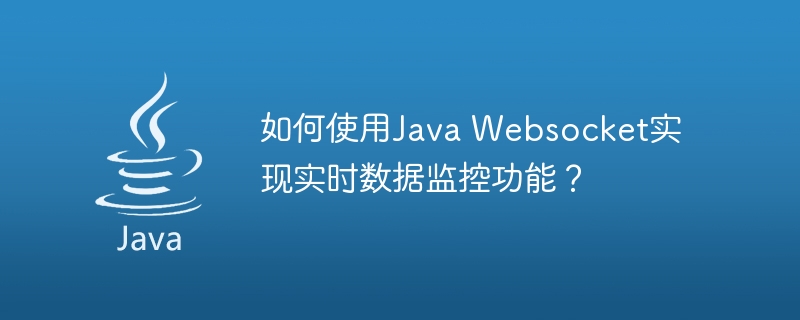

How to use Java WebSocket to implement real-time data monitoring function?
Abstract: With the continuous development of Internet applications, real-time data monitoring function has become one of the necessary functions for many applications. This article will introduce how to use Java WebSocket to implement real-time data monitoring functions and provide specific code examples.
Keywords: Java WebSocket, real-time data monitoring, code examples
1. What is WebSocket?
WebSocket is a network protocol that can establish a persistent connection between a browser and a server that implements the WebSocket protocol to achieve real-time communication. Compared to the traditional HTTP request-response model, WebSocket provides lower latency and higher efficiency in communication between the client and server.
2. Why choose Java WebSocket?
Java WebSocket is part of Java EE 7. Real-time data monitoring functions can be easily implemented using Java WebSocket. Java WebSocket provides WebSocket APIs and annotations, allowing developers to easily use WebSocket technology in Java applications.
3. Implementation steps of Java WebSocket real-time data monitoring function
import javax.websocket.OnMessage;
import javax.websocket.Session;
import javax.websocket.server.ServerEndpoint;
@ServerEndpoint("/dataMonitor")
public class WebSocketEndpoint {
@OnMessage
public void onMessage(String message, Session session) {
// 处理客户端发送的消息
}
}<servlet>
<servlet-name>javax.websocket.Endpoint</servlet-name>
<servlet-class>org.apache.tomcat.websocket.server.WsSci</servlet-class>
<load-on-startup>1</load-on-startup>
</servlet>
<servlet-mapping>
<servlet-name>javax.websocket.Endpoint</servlet-name>
<url-pattern>/dataMonitor</url-pattern>
</servlet-mapping>var socket = new WebSocket("ws://localhost:8080/dataMonitor");
socket.onopen = function() {
// WebSocket连接建立成功后的处理
};
socket.onmessage = function(event) {
var message = event.data;
// 处理从服务器接收到的消息
};
socket.onclose = function(event) {
// WebSocket连接关闭后的处理
};@ServerEndpoint("/dataMonitor")
public class WebSocketEndpoint {
@OnMessage
public void onMessage(String message, Session session) {
// 处理客户端发送的消息
try {
session.getBasicRemote().sendText("Hello Client");
} catch (IOException ex) {
ex.printStackTrace();
}
}
}So far, we have completed all the steps to use Java WebSocket to implement real-time data monitoring functions.
Conclusion: Java WebSocket provides convenient APIs and annotations, allowing developers to easily implement real-time data monitoring functions in Java applications. Through WebSocket, real-time two-way communication can be achieved between the client and the server, which facilitates the implementation of real-time data monitoring functions.
References:
Note: The above code examples are for reference only. The specific implementation may vary depending on the application framework.
The above is the detailed content of How to use Java Websocket to implement real-time data monitoring function?. For more information, please follow other related articles on the PHP Chinese website!
